The Bird of Prey Tonearm Takes Flight!
Top of the tonearm food chain?
One thing you learn from doing this for decades is that orthodoxy can be a straitjacket. You must give odd birds a test flight before you dismiss them. Then you dismiss them! Ah, but I’m kidding my friend Robin Wyatt who, yes let’s immediately dispense with that part: the importer is a friend and a one-time business partner in the enterprise of releasing Rufus Reid Presents Caelan Cardello.
That worked out well for everyone! And his wife Carol and mine show dogs and are friends as well. They are part of "the dog world" and participate in "dog shows", which when people ask what those are like I say, "they are like hi-fi shows, only with less pooping in the elevators".
As a few other friends who have offered equipment for review have found out, I don’t let friendship get in the way of honest reviewing. Unforgiving readers are looking over my shoulder as I write. Friends are more forgiving and if a review breaks a friendship, it wasn't much of one to begin with.
The Bird of Prey
This unipivot tonearm defies convention in more than a few ways. First, it doesn’t have an anti-skating feature. That’s almost grounds for dismissal in certain quarters—J.R. Boisclair’s for instance, who thinks skating compensation is near the top of the most important set-up parameters. He's probably reading this rolling his eyes. I figured Robin knows I share J.R.’s skating position, so The Bird of Prey must somehow solve skating without special compensation, or why else would he want me to listen to and review this arm?
The underhung 8 inch arm supplied with the Yukiseimitsu AP-01 Turntable was a totally unexpected and very pleasant listening surprise: underhung, and also with no anti-skating compensation because there’s a belief among some in Japan that skating is among the worst vinyl playback sins (in that they agree with Boisclair) and that since, they believe, skating is caused by overhang and tonearm offset angle, eliminating those eliminates skating!
They are more than happy to exchange skating for a relatively large increase in harmonic distortion produced by the increased LTE (lateral tracking error), which is what underhanging the arm and doing away with the offset angle creates (for those here unfamiliar, "overhang" is literally the distance the stylus "overhangs" the spindle (the pivot to spindle distance [arm length] plus the overhang equals an arm's effective length).
However, while the underhang and lack of offset angle diminishes skating it does not eliminate it. Instead, on a blank disc the arm skates in to the center of the record and stops. Place it near the end of the side and it skates out to the center and stops (I'm no suggesting using a blank record to set anti-skating).
Point is, despite these problems, the AP-01 sounded great, probably in part because even order harmonic distortion can sound pleasing! I enjoyed the listen, but I'd have been happier had they then a use your own arm option that they now do. To be clear: the B.O.P.". is neither underhung nor does it lack an offset angle.
Other B.O.P. Features
Lack of anti-skating out of the way, consider the rest of the design front to back: the headshell is best described as "vestigial". It's a relatively light, elongated "U" shaped empty-in-the-center piece of machined aluminum (or as one observer sarcastically put it, "it's like a tuning fork") with a platform-like inner surround. The cartridge first bolts to a thin metal disc with finger lift that hangs from the center of the "U" shaped section secured by a small screw riding in the inner-surround that adjusts both overhang and offset angle. The headshell's rear is a thick, integral aluminum block with a center opening into which the arm tube is clamped. The picture is worth 1000 words, but the more you consider it the more you have to respect it as some pretty neat precision machining.
The headshell is available in various weights and it's even available with an SME style collet for SPU cartridges. In fact, the options for this arm are too great to cover in a review and could lead to some confusion, so let's just say, if you're interested ask about your desired options.
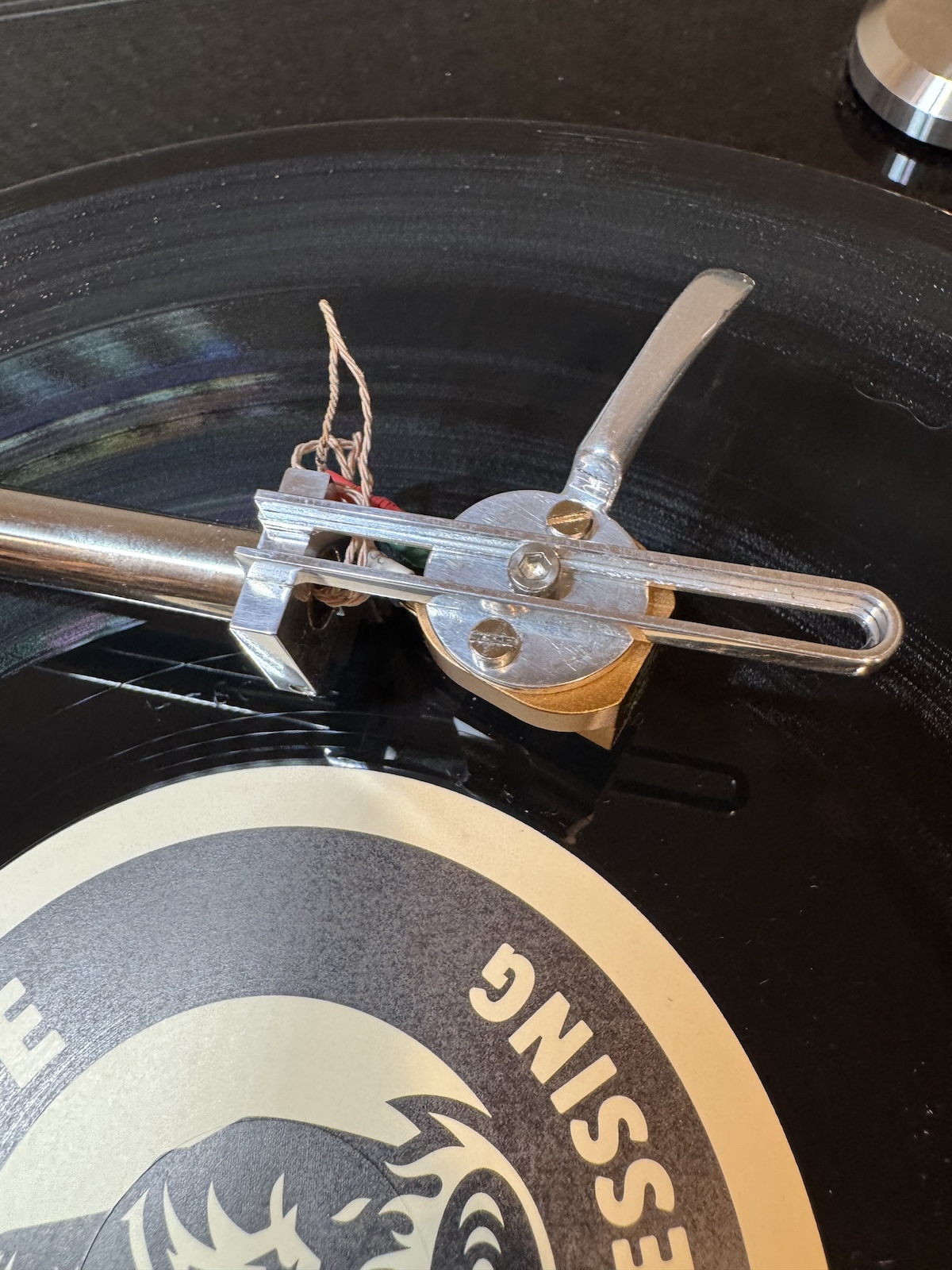
B.O.P. comes with two arm tubes, one straight and one "J" shaped. The standard "J" shaped arm is made of Brazilian Pernambuco wood, obviously hollowed out for the wiring to pass through. The review sample's extra cost straight pipe is fabricated partly from Pernambuco wood that's used for making violin bows among other things and partly from aluminum. It's apparently an endangered species and subject to smuggling (the wood, not aluminum). I am hoping Thai-Scandinavian Engineering doesn't use smuggled wood.
At one point Mr. Wyatt told me that the manufacturer can "tune" the tubes to better compliment the buyer's musical tastes. This for me is a red flag. It tells me to expect a purposely "colored" listening experience. I'd rather the cartridge added the color, but your opinion/needs may differ, so onward!
You can order the wand in various lengths depending upon your turntable's needs (mine needs a 12" arm). The arm wand includes the internal wiring—a pure silver formulation exclusive to TSE) that exits out the side of the arm in a stiffened enclosure and terminates in XLR plugs.
Thai-Scandinavian Engineering can provide XLR jacks-to-XLR plug wiring that goes from the termination point to your phono preamp, or you can have XLR jacks to single-ended RCA or you can have it wired for field coil cartridges, or however you wish. You have to provide a means to secure the relatively heavy XLR junction.
Thai-Scandinavian Engineering provides this rig for permanent installations:
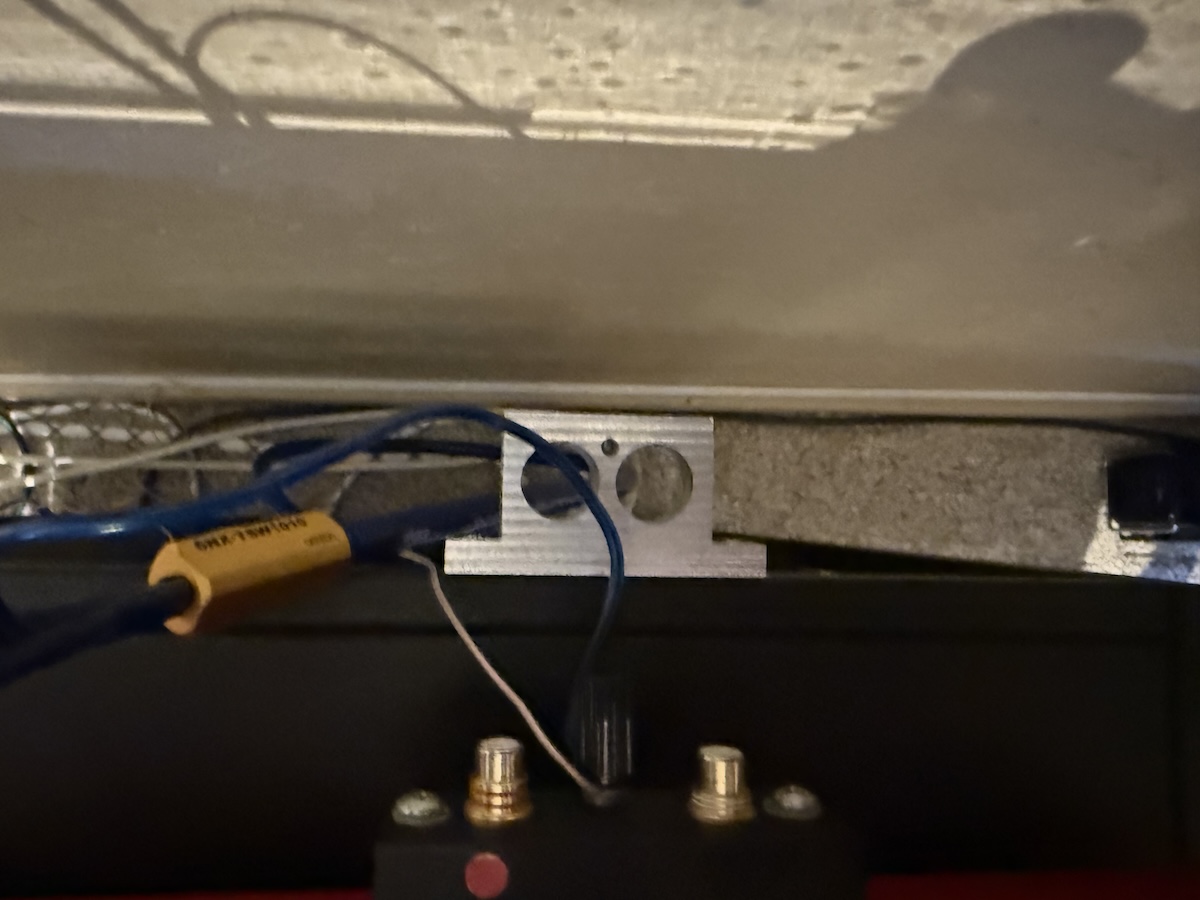
Here's how I did it for review purposes:
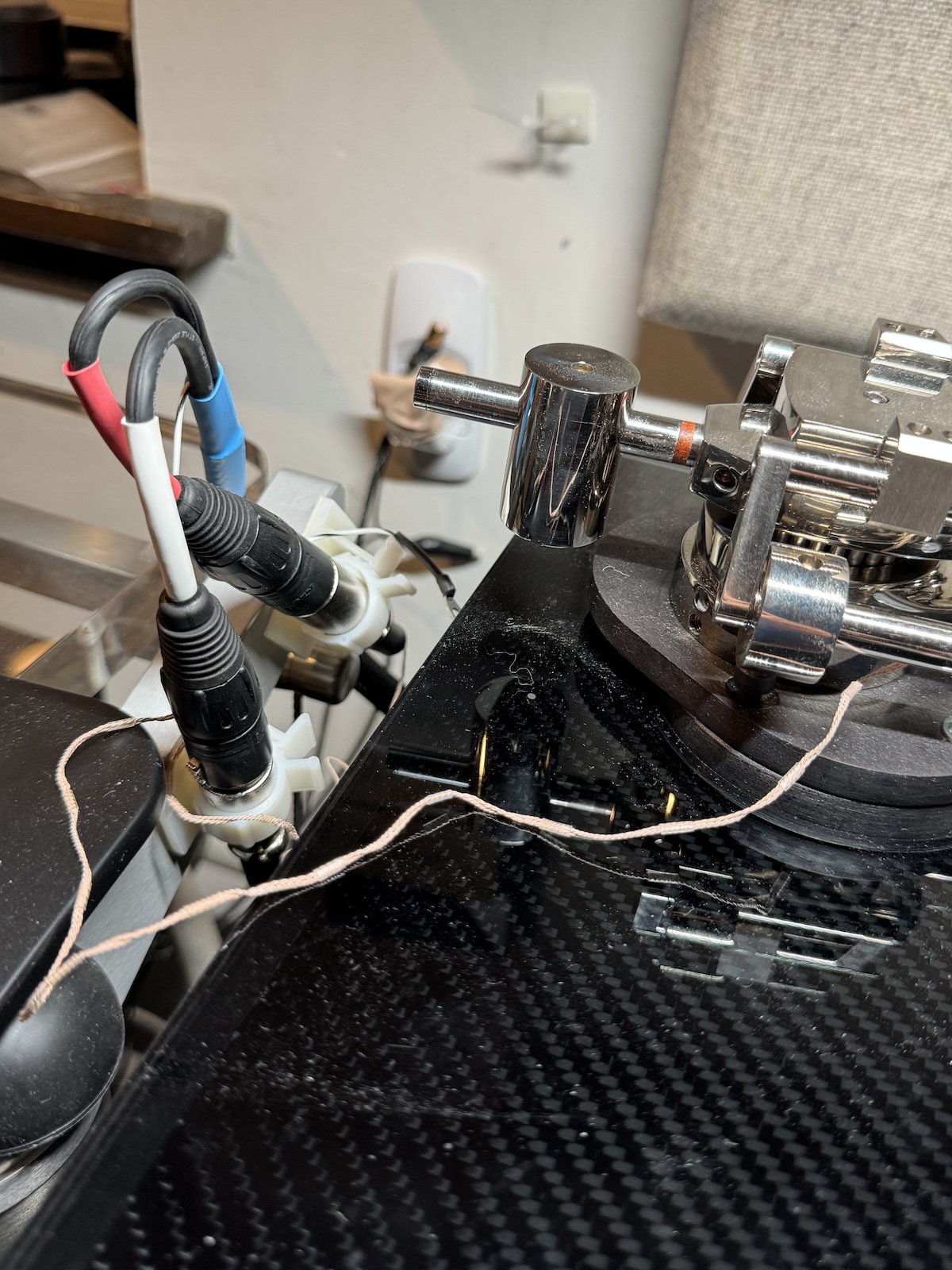
The draped wiring exiting the side of the arm is unavoidable and will not be to everyone's esthetic liking. Had this been a permanent installation I could have neatened it up somewhat and of course I would have used the permanent aluminum block shown above.
Now let's get to the main attraction, the magnetically stabilized, viscous damped, high mass bearing housing of nickel plated brass, and assorted unusual and unique parts. Again, a picture is worth 1000 words:
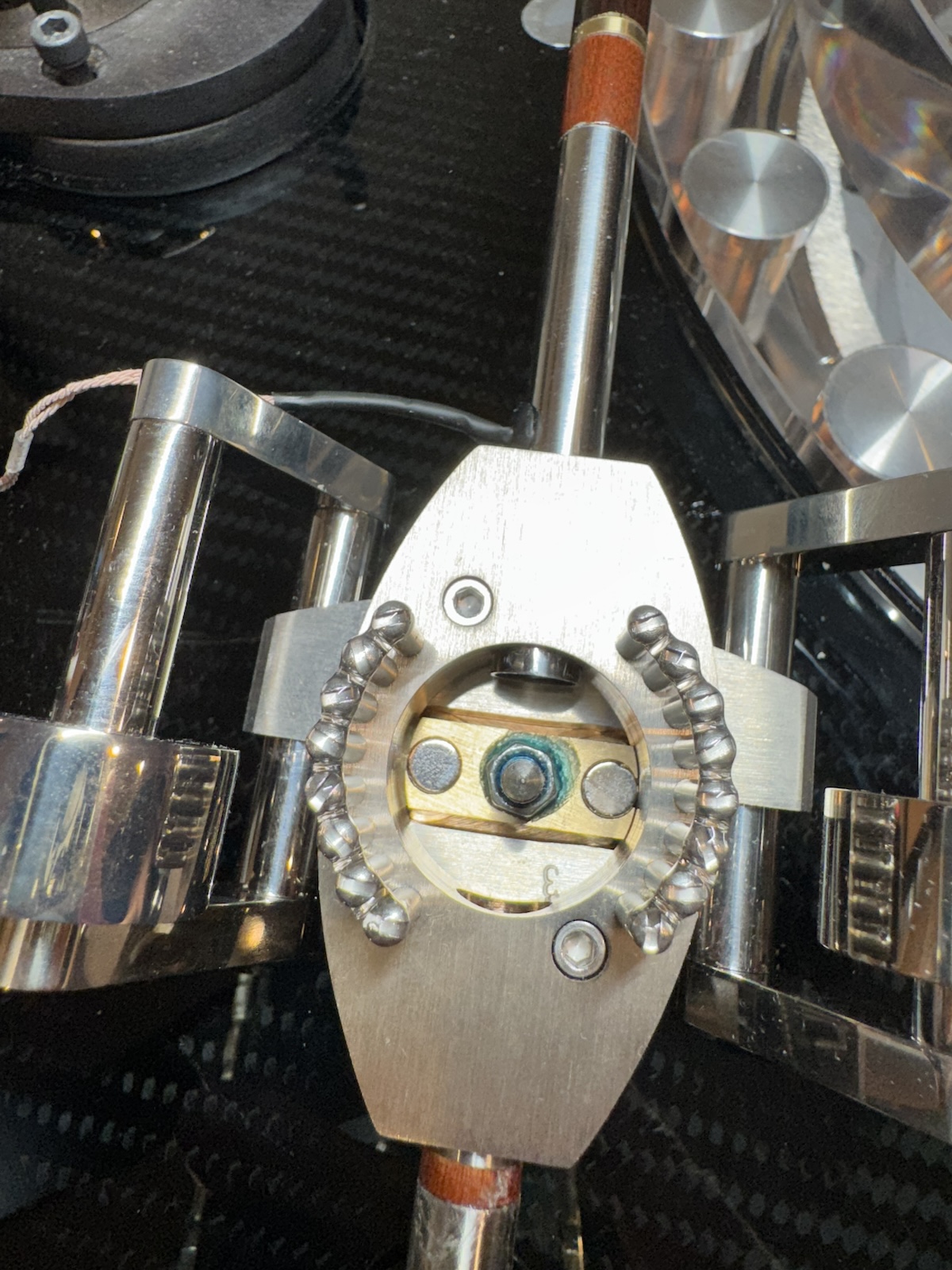
With the bearing assembly flipped upside down you are looking down on the unipivot point locked into a brass block that also contains a pair of bearing stabilizing disc magnets, one on either side of the unipivot point. The two sets of 8 teeth, each grooved, sit in a viscous fluid filled damping trough. Unlike single "paddle" damping systems, this one produces a great deal of "drag". The more the fluid, the greater the drag effect. The greater the fluid viscosity the greater the drag effect.
Here's another view that better shows the pivot point and "teeth" length and behind it the bearing cup and damping trough. You can see the arm wand's end on one side. The aluminum counterweight stub has wood damping inside.

Here's the bearing cup and trough viewed from directly on top. The cup can be raised, lowered and locked in place via a pair of grub screws to set VTA/SRA.
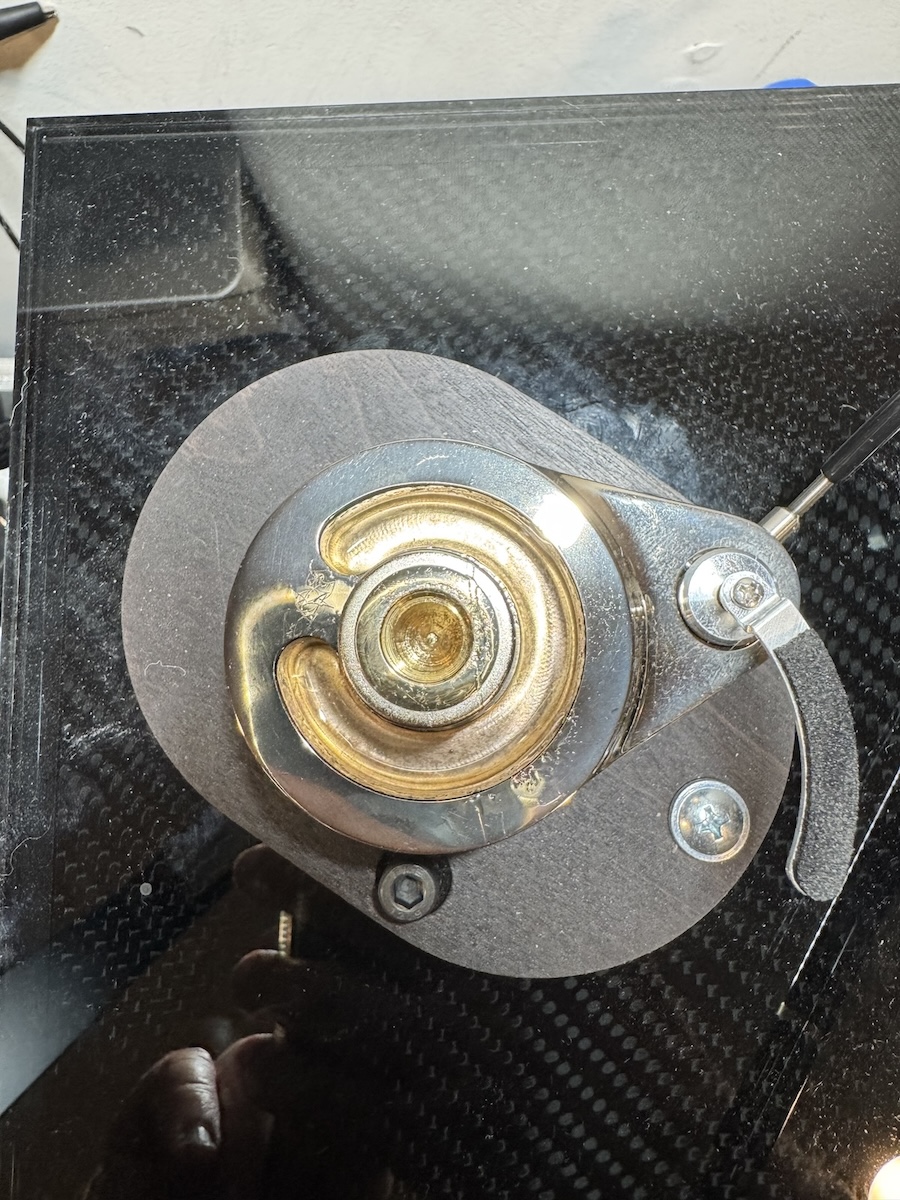 Here's how the bearing looks in place:
Here's how the bearing looks in place:
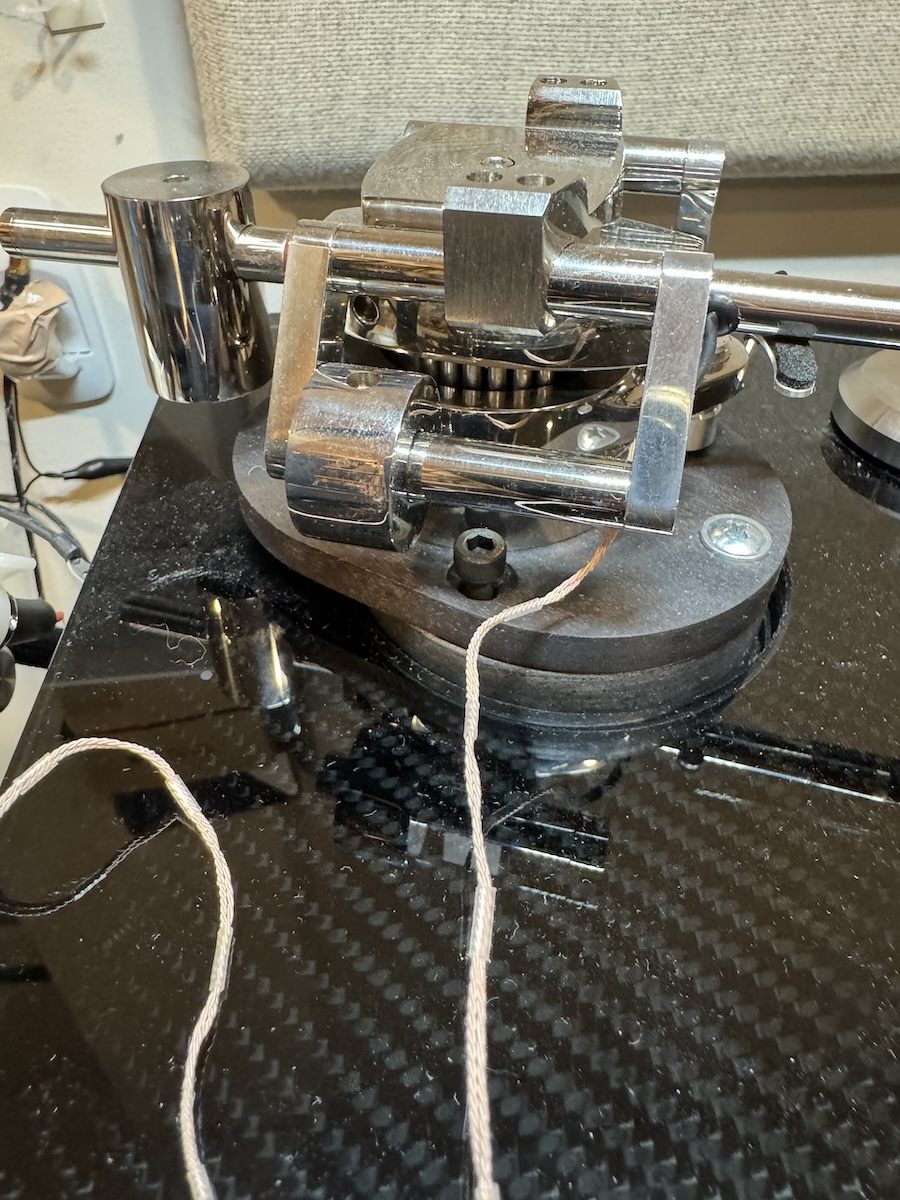
Now you see the bird's "wings". Obviously one on either side. These can be raised and lowered to provide extra stability and note the weight at the rear (one on each side). Those can be slid forward ahead of the unipivot bearing to change the arm's effective mass. They can also be used to provide lateral balance-like how SME balanced its knife edged bearing. That's the arm's unique game plan. You can adjust azimuth either by rotating the arm tube within the bearing block, or preferably by rotating the headshell.
Though there's not yet an instruction manual the importer sent a note from the arm's designer regarding the arm's "Universally Adjustable Effective Mass, which he says means "...not only compatability with practically any cartridge, but also the ablilty to revise system resonance from the ubiquitously accepted 10Hz down to 5Hz or less; a natural requirement of half-speed transcription whereby once brought back up to speed, a 10Hz system resonance would otherwise create an unwanted 20Hz spike in the resulting media (I'm not sure I can agree with this claim unless I'm not fully understanding it. The resonance is in playback and I don't see how the 1/2 speed mastering produces a 10Hz resonance in the lacquer that doubles upon vinyl playback_ed.) Adjustment of effective mass is simplicity itself. Start by removing the end stub. Affix cartridge in situe in accordance to your prescribed alignment, then weigh on a balance. The author uses a cheap digital balance that cost <$1, but you can buy dedicated balances if you choose. Adjust outrigger weights forwards or backwards until the desired effective mass is achieved. Now reinsert endstub and attach weights until the desired VTF is achieved. In order to establish your required effective mass a number of online resources are available, simply search for “cartridge resonance calculator” – here is a useful example from Resonant Frequency.
Bird of Prey Arm Behavior
If you are paying close attention you've noted where the arm's very high bearing mass is located: well above the pivot point. Like Franc Kuzma's 4 Point, the Bird of Prey is a negatively balanced arm. That is, the mass of the arm, unlike most unipivots, is located above the pivot point. Most unipivot arm designers try to locate the mass below the pivot point, to add stability (VPI, original Graham 2.0, etc.). Like the 4 Point, so much mass is above the pivot point, when you raise the arm from its resting position it wants to continue its upward path. The Kuzma Safir is so negatively balanced, if you raise it up enough, it parks itself with the arm tube pointing up at about a 45 degree angle.
This is not a design defect in either the Kuzma or the Bird of Prey, but you must be careful setting tracking force and obviously having vertical damping is critical playing back warped records because the arm will tend to want to continue its upward movement reacting to a warp.
With a negatively balanced arm, the higher up above the record surface you measure VTF, the more it will be "off" into negative territory and so the actual VTF at the record surface will be too high. Positively balanced arms like SAT's produce the opposite result. That is, the higher off the record surface you measure VTF, the heavier it will read there but will be lighter at the record surface, so you have to add tracking force to compensate. It's less of an issue with 12 inch arms. SAT provides a detailed formula for this. The practical solution is to use a stylus force gauge that measures at record surface.
If you lift the Bird of Prey too high up the arm tends to "go up". You have to lower it adjacent to the platter to below record level to get it to behave normally. Again, not a problem once you understand why it's behaving as it is, and what to do about it.
Which forces me to repeat another issue: the lack of an owner's manual. Everything I did was run past Robin Wyatt. A $15,950 arm deserves an owner's manual as do buyers spending $15,950.
The first cartridge installed was (appropriately) a Miyajima Labs INFINITY mono cartridge. Robyatt Audio imports the brand, plus at almost 15 grams it's heavy and I figured the vestigial headshell would benefit from some mass (honestly, I don't understand the design rationale of low mass headshells). Plus it tracks at 3.5 grams.
The arm's lateral movement, for obvious reasons is somewhat sluggish and its behavior unlike that of most other arms (perhaps a Well Tempered arm, which sits in a silicone pool would behave similarly). I didn't bother trying a WallyTractor on it to check the nonexistent anti-skating because even if had anti-skating it clearly wouldn't move laterally or move much if it moved at all.
I'll get to how the arm behaved with a more typical stereo cartridge and how it did on the Ortofon test record's trackability bands but for the mono cartridge installed I was more interested in how it sounded and tracked playing mono records.
Mounted on the B.O.P. the Infinity's familiar, notably rich, full, startlingly "the music's there" minus any mechanical aftertaste was fully there only with greater clarity and intensity than I've ever before heard it: rich, vivid but perfectly balanced and not at all cloying or leaning particularly on the midband to add heft and "richness". Between note silence was immediately noticeable as was "stop and start" precision.
Masterpieces by Ellington (Analogue Productions 45rpm edition) produced overwhelmingly rich and full three-dimensional images, each distinctly presented in three-dimensional front-to-back space. The cartridge/arm combo delivered the opening lower register clarinet line that sings the "Mood Indigo" melody deeply, richly, and as mellifluous as I've ever heard it yet the horns lost none of their brassy tone and reeds vibrated correctly. When "Yvonne Lanauze" (real name Eve Duke) enters singing, she's in your room. Well, that effect is true with most high quality tonearm/cartridges, but with this one, let's say she's in you room!!!! The humorous trumpet "wah wahs" that follow should sound wet and they did.
A mono record binge followed and I won't list any so we can keep moving here, but for mono records, the B.O.P./Miyajima Labs Infinity combo was spectacular. If you're looking for a second arm position option for mono playback, this combo is easy to recommend.
An Unknown and Known Stereo Cartridge
After spending a lot of time with the INFINITY mono, it was time to install a stereo cartridge. First Mr. Wyatt brought over a Tzar DST with a Corian body specially made for him (cost approximately $10,000). It tracks at 6 grams. The one I reviewed in Stereophile had a recommended 2.4 gram VTF. 6 was scary high for me so I started with a mono record (lateral cut grooves, less likely to be damaged, if at all by high tracking force) and I listened to and recorded a track from an excellent Craft reissue of Kenny Burrell's eponymous 1957 Prestige release (CR00861). I'd already recorded it using the $1199 Ortofon MC X40 MC cartridge mounted on the $19,000 Supatrac Nighthawk and you can hear that combo in that review.
I found this combo's playback produced soft indistinct transients on everything. Yes, the midrange was rich and creamy and female vocals were lush and you could say sonically sensuous, but overall to my ears the performance was mushy and lacked rhythmic authority and transient "snap". I've got the Tzar/Bird of Prey Burrell recording but unless there's strong demand from readers I'm not going to post it.
The few stereo records I was willing to put under 6g VTF were also distinctly and similarly soft. Not my thing. I recall being more enthusiastic about the earlier Tzar I reviewed in Stereophile that tracked at 2.4 grams. Mr. Wyatt sent a bottle of less viscous silicone and that did reduce the sonic thickness as well to some degree but it didn't change the overall presentation or my reaction to it.
But this is not a Tzar review. nor is it a review of Mutech's RM-Hayate MC cartridge (price sensitive to tariff and currency conversion, but around $8000), and a review is forthcoming but with the demise of Transfiguration, this ring magnet based, boron cantilevered, semi-line contact stylus cartridge is in that same rarified category and its sonic presentation is way more to my sonic liking. It spent weeks on the Supatrac before I moved it to the Bird of Prey so I had a very good handle on its performance, both musically and mechanically.
Moved to the Bird of Prey, I first chose to check the horizontal and vertical resonant frequencies using the Hi-Fi News test record. The silicone diminished somewhat the intensity of the resonances but both vertical and horizontal were around 8Hz so I felt no need to adjust the effective mass.
The RM-Hayate MC tracked cleanly the 50µm and 60µm tracks of Ortofon's accuracy in sound test record and tracked with but a slight bit of right channel buzzing the 70µm and 80µm tracks both of which are more highly modulated than any music track its going to encounter and that is very good performance, despite there being no anti-skating mechanism.
Just to be clear, that doesn't mean the cartridge damper isn't being unevenly pressured across the record surface, just that it doesn't show in the test track or as I found out enjoying dozens of records, in playing music through the combo.
But one record in particular was sufficient for me to tell you about this arm's sonic character and why it has a following and that record is Anthony Wilson's new one, House of The Singing Blossoms on Sam First Records (not related to the French Sam Records label).

I was sent a test pressing with no information and I chose to not look at the email containing it (or to my friend Bob Levy's Positive Feedback review) because I just wanted to listen. Thus I first encountered the double LP live set through the Mutech cartridge/Bird of Prey combination, with the arm mounted on the Wilson-Benesch Prime Meridian turntable please do not forget.
The live set begins as a piano trio—bass, drums, piano and then the horns enter—all obviously arranged by Anthony Wilson. It's in his blood after all. And the sound is spectacularly three-dimensional and harmonically rich and full—almost as if my system had turned "tubular". The background is drop dead quiet. The instruments appear in three-dimensions against a black backdrop. The horns effectively growl, the saxophones have reedy essence, images are stable and then the crowd applauds and the room opens to the applause, though there's little "room sound essence" so that it's not clear until the applause that it's a live recording. A baritone sax wails in the right channel, deep and chesty. Dynamics are outstanding. The acoustic bass has weight and natural transient detail.
Finally Wilson takes a solo in the left channel and he's right there in three dimensional, tactile space. The outstanding sonics encourage you to crank it up, which I did. When the track ends, the applause is there against the black backdrop and how can it get better than this? Without credits I don't know who's playing (other than Wilson).
Following the applause Wilson starts playing a very familiar tune. It's Joe Zawinul's "In a Silent Way" and you can feel Wilson's fingers touch the strings. There's a bit of piano, bass and drums and then the horns explode delicately across the stage. The recording is insanely great I don't care analog, digital, whatever. There's a bass solo center left and the drummer taps time off to the right, and back on the stage and so it goes. Following the familiar track comes another: Zawinul's
What is there to criticize about this recording and how the cartridge and arm present it? There's nothing to criticize. I don't care what are your particular sonic tastes, I think you'd like this presentation!
Then it was time to play it on 1)The Wilson-Benesch Graviton tonearm fitted with W-B Tessellate Ti-s cartridge 2) The Acoustical Systems AXIOM tonearm fitted with Lyra Atlas Lambda SL mounted on the A*STELLAR turntable (nothing at the time was mounted on the Supatrac Nighthawk). Playing this record was not a chore!
While the two other arm/cartridges (and the belt drive turntable) are different and don't sound identical, the two arms mounted on different turntables sounded closer to one another than they did to the Mutech/Bird of Prey, which produced a warmer, more harmonically saturated and you could even say more inviting presentation.
Were you sitting here comparing you might conclude that the latter two set-ups were kind of drab sounding and lacking in inviting harmonic richness. Or you might conclude that the Mutech/B.O.P. presentation though exceedingly pleasant—more than pleasant and actually more like "real live music" —was built upon an incredibly pleasing, even handed set of colorations so well delivered and balanced that they were difficult to impossible to hear until you made the comparison and why bother doing so when you're having such a great time playing tunes?
Remember that I had the Mutech on the Nighthawk for quite some time and played many records on that combination. The Mutech does have a textural rich, physical presentation with accomplished, generous harmonics and is not at all "cool" or analytical sounding— the sonic direction to which the Tessellate mildly gravitates towards, but what was a pleasing direction on the Nighthawk was full blown on the Bird of Prey.
Conclusion
The Bird of Prey is an odd but unusually visually attractive, intriguingly designed magnetically stabilized unipivot bird. I don't understand the reason(s) for light weight at the headshell, though I do understand high mass in the rear. Affixing the cartridge holder with the single screw leaves an indentation that over time can make setting overhang difficult as the screw seeks to settle in the indentation rather than where you wish to affix it, though many other arms have a similar issue and it can be argued that the single point connection is an effective energy drain point.
The lack of anti-skating is still a concern even if it appears to not be an issue. Chances are good there's uneven force applied to the cantilever damper, though the silicone diminishes it to some degree. Having a way to easily change effective mass to better match cartridges is a fully useful feature. The arm's versatility and available head shell, wiring and arm tube options are real pluses, especially for vinyl enthusiasts who like to regularly explore "options".
Many unnamed records later in all of these comparisons, and being fully aware that the Bird of Prey manufacturer offers sonic "flavors" to your liking, it's difficult to perfectly pin down the arm's mutable, "moving target" sound, but based upon what I heard I think the design's full rich sonic character heard through all three cartridges used, is "built into" the design.
Some of the consistent harmonic richness is an exaggeration, some of the notable silence—unusual in character— is a suppression of sustain and/or highest frequencies (you can more easily hear the room sound behind the instruments before the applause on the Wilson nonet album through the other arms) and I believe had I the time or inclination to try additional familiar cartridges I'd hear these same characteristics filtered through those cartridges' sonic characters.
At the same time every record I played using the Mutech/B.O.P. combination sounded vital, "musical", enjoyable and uncolored (even when I was convinced I was hearing a consistent character) because it was evenly applied across the full frequency bandwidth and this arm does deliver the full top to bottom bandwidth free of audible lumps or bumps.
I certainly would avoid using it with a warm sounding cartridge unless you can't get enough of that sound, and I'd definitely try to pair it with a lean, detailed, "fast" cartridge, which I bet would produce an idea balance or detail, speed and saturated colors. But that's my taste.
And finally if you're looking for an arm to put in a secondary position for use with a mono cartridge, to give you that "old school" mono sound, you could start and stop with the Bird of Prey and you definitely won't regret it. I fully enjoyed my time with The Bird of Prey.
Specifications
The Bird of Prey tonearm is available in multiple lengths, including a 12-inch version reviewed here. Price of arm as reviewed: $15,950
. Specifications (for the 12-inch version)
Effective Length: 304.8 mm (12 inches)
Mounting Distance: 291.6 mm
Offset Angle: 18 degrees
Overhang: 13.2 mm
Pitch of Headshell Mounting Grooves: 12.7 mm
Effective Tonearm Mass: 14g-52g
Cartridge Weight Range: 7-20g
Tracking Force Range: 1.5-10g
Minimal Null Point: 125mm
Maximal Null Point: 251.7mm
Tonearm Weight: 520g
Features:
a magnetically stabilized, viscous-damped unipivot design. The tonearm allows for azimuth and VTA adjustment and can use different armwands. According to the importer, it can accommodate a wide range of cartridge weights.
Manufacturer Information
Manufactured in Thailand by Thai-Scandinavian Engineering and distributed worldwide by Robyatt Audio


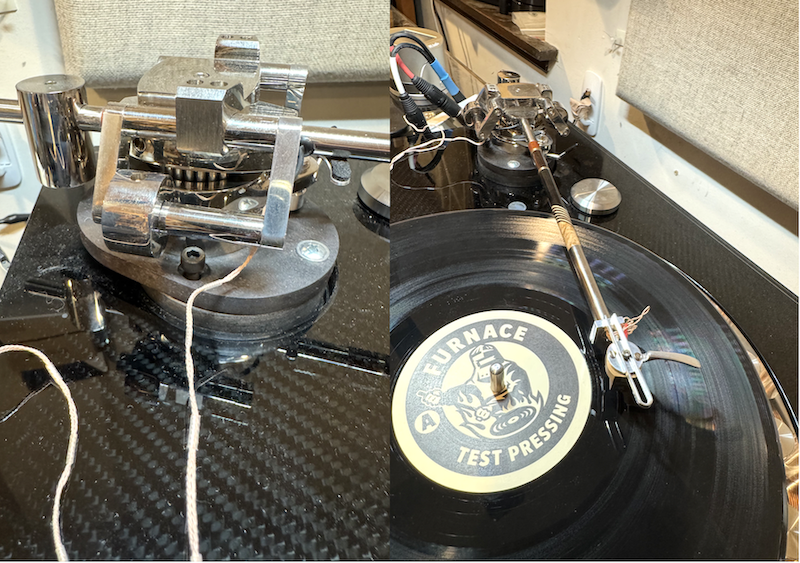


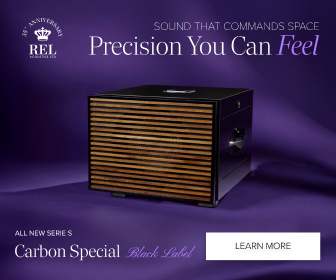

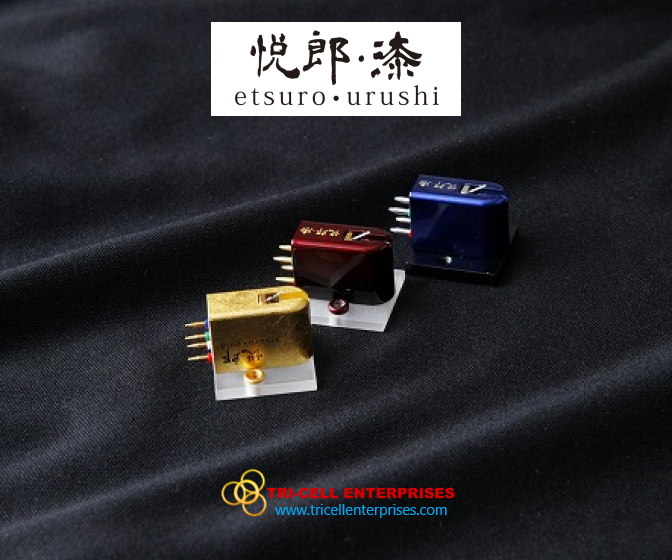
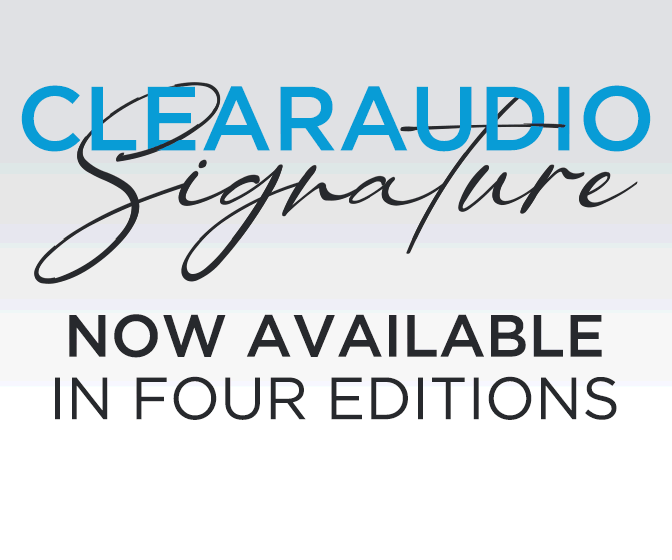
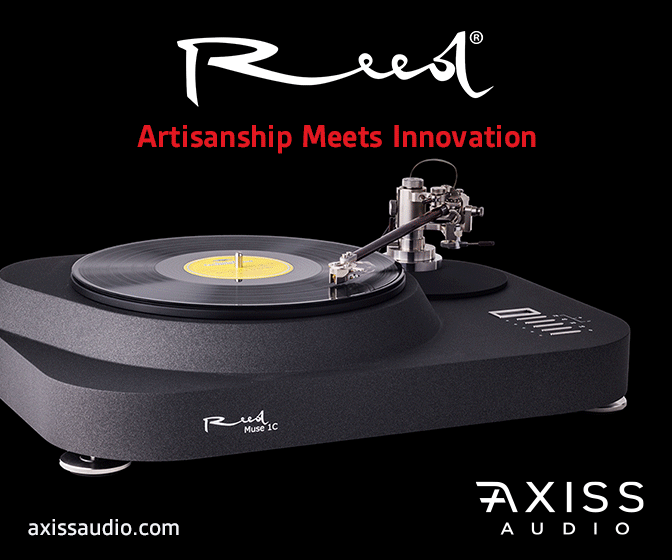
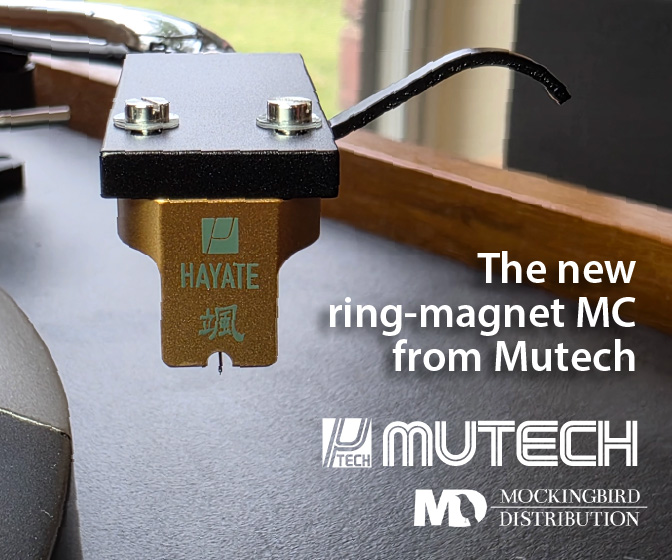
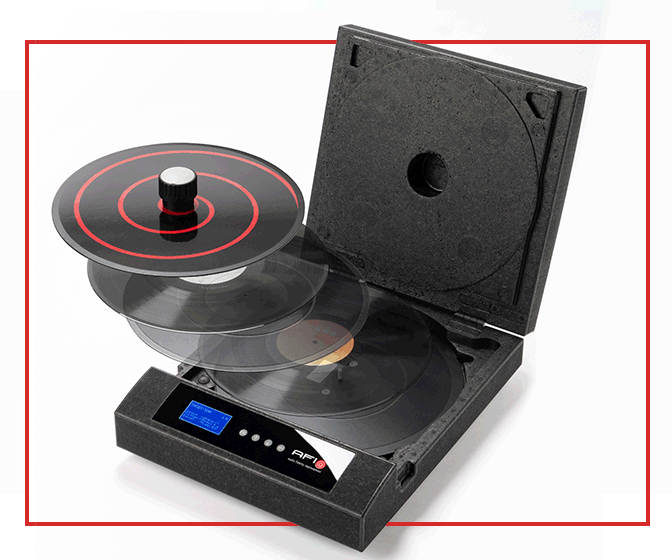

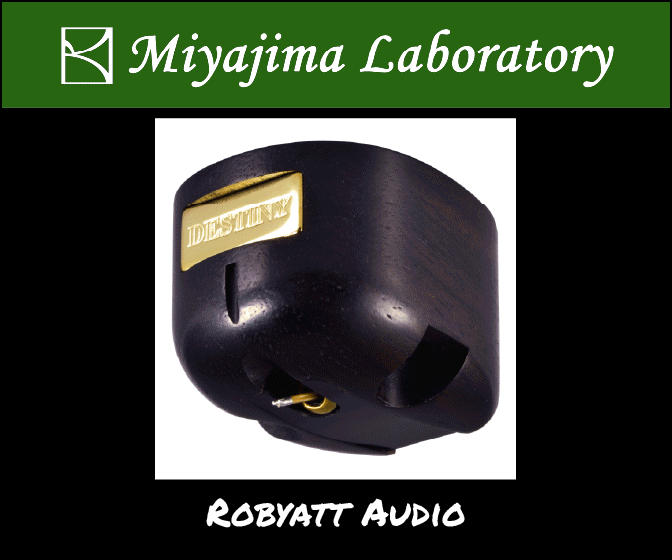


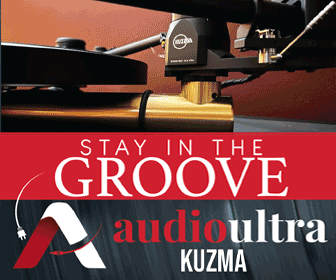


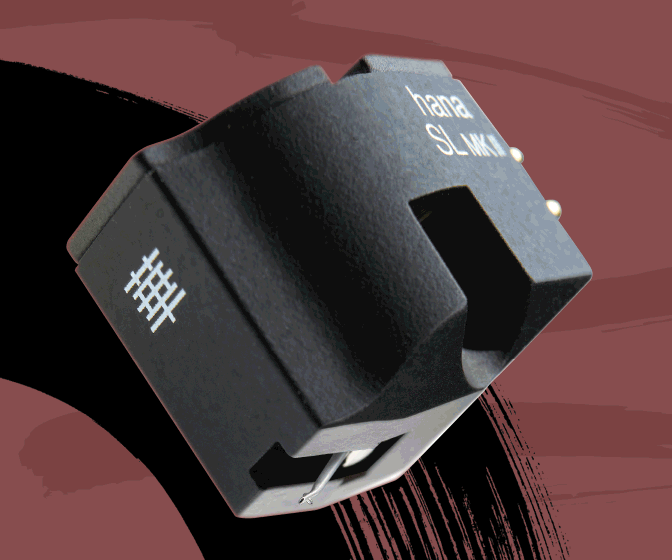
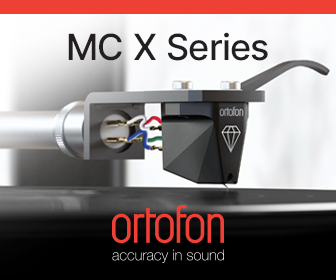
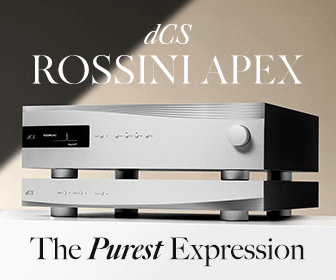
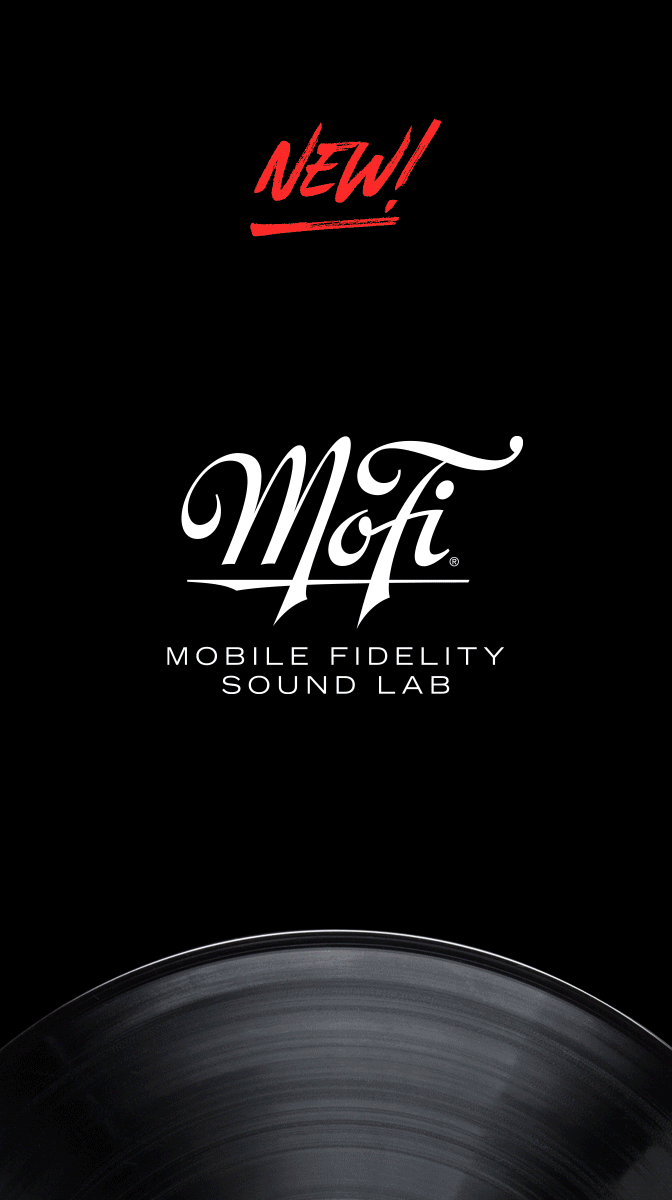


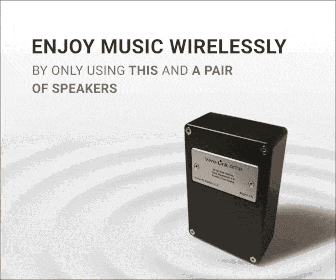
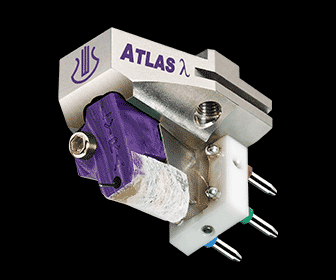

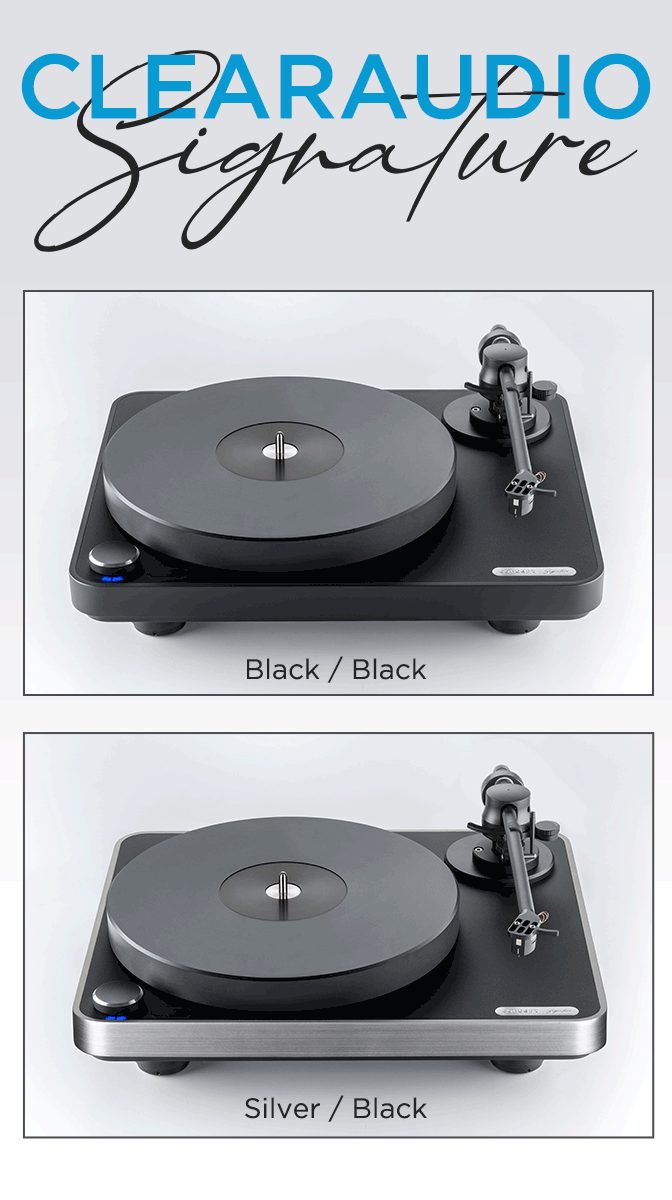


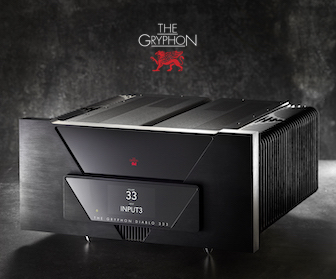
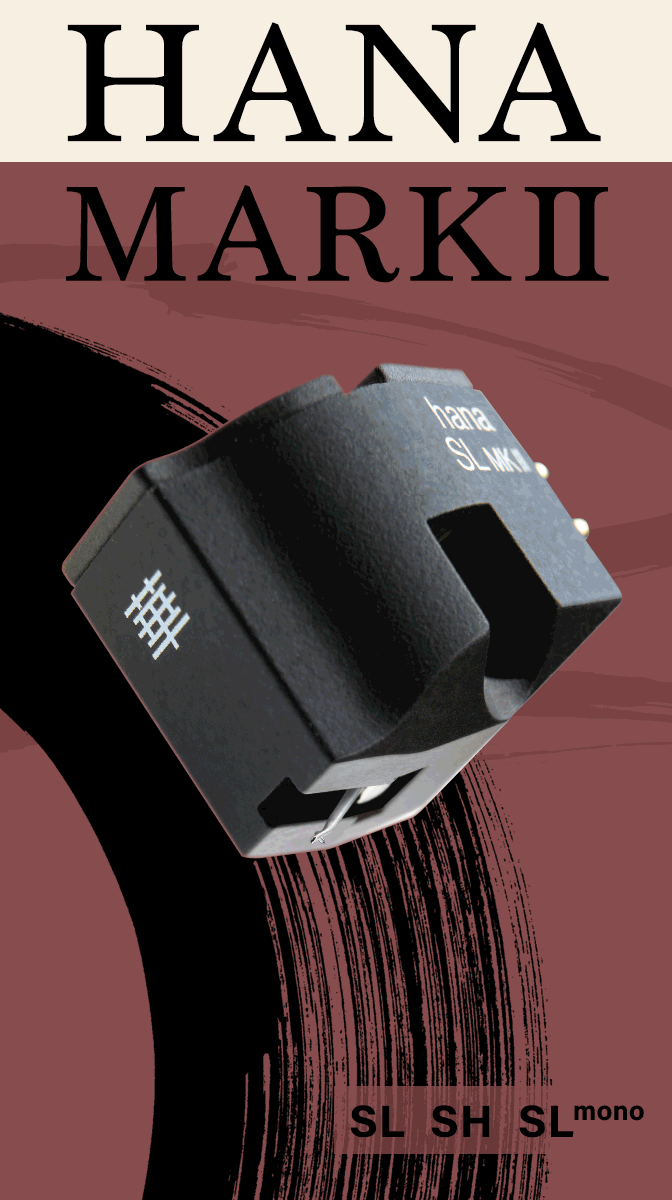



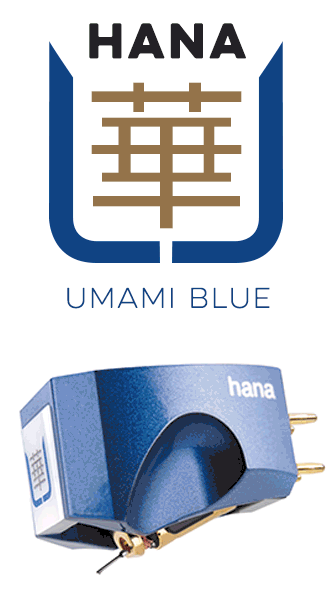





.png)








